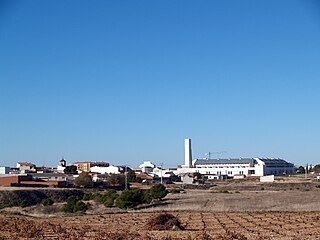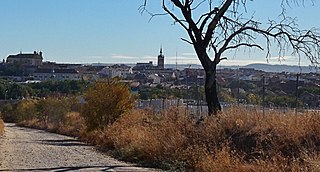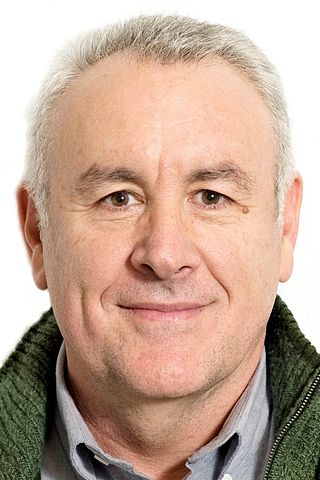
Castilla–La Mancha is an autonomous community of Spain. Comprising the provinces of Albacete, Ciudad Real, Cuenca, Guadalajara and Toledo, it was created in 1982. The government headquarters are in Toledo, which is the capital de facto.

Talavera de la Reina is a city and municipality of Spain, part of the autonomous community of Castile–La Mancha. Its population of 83,303 makes it the second most populated municipality of the province of Toledo and the fourth largest in the region.

The Spanish motorway (highway) network is the third largest in the world, by length. As of 2019, there are 17,228 km (10,705 mi) of High Capacity Roads in the country. There are two main types of such roads, autopistas and autovías, which differed in the strictness of the standards they are held to.

Bargas is a municipality of Spain located in the province of Toledo, Castilla–La Mancha.

Noblejas is a municipality of Spain located in the province of Toledo, Castilla–La Mancha. The municipality spans across a total area of 69.67 km2 and, as of 1 January 2021, it has a registered population of 3,721. Radio Exterior has transmitter its 0.5 km south of Noblejas. It belongs to the traditional comarca of Mesa de Ocaña.

Quintanar de la Orden is a municipality of Spain located in the province of Toledo, Castilla–La Mancha. The municipality spans across a total area of 87.87 km2 and, as of 1 January 2023, the municipality has a registered population of 11,119. It is part of the Mancha Alta de Toledo comarca.
Velada is a municipality located in the province of Toledo, Castile-La Mancha, Spain. According to the 2006 census (INE), the municipality has a population of 2,436 inhabitants.

Illescas is a town and municipality of Spain located in the province of Toledo, Castilla–La Mancha. The municipality spans across a total area of 56.75 km2 and, as of 1 January 2020, it has a registered population of 30,229, which makes it the third most populated municipality in the province. It belongs to the traditional comarca of La Sagra.

Valdemoro is a municipal district, located in the Southern zone of the autonomous community of Madrid, Spain. Located 27 kilometers from the capital, Valdemoro is officially part of the comarca of La Sagra, though it is generally also included in the Madrid metropolitan area.

La Sagra is a region in central Spain lying between the cities of Madrid and Toledo. In a wider sense, it includes municipalities belonging to both the south of the Community of Madrid and the north of the province of Toledo. In a more restricted sense, concerning the municipalities in Castilla−La Mancha, the Toledan Sagra includes municipalities in the right (north) bank of the Tagus up to the northern provincial border with the Madrid region, whilst its Western limits are moot.

Cayo Lara Moya is a Spanish politician. He was the leader of United Left (IU) from December 2008 to July 2016. He is also a member of the leadership of the Communist Party of Spain.

The Battle of Seseña was a Republican-Soviet assault on the Nationalist stronghold of Seseña, near Toledo, 30 km south of Madrid in October 1936 during the Spanish Civil War. After the fall of Talavera de la Reina and Toledo in September 1936, the Nationalist troops pushed towards Madrid and in October they were 30 km from the city. The Republican government which had received new Soviet weapons decided to launch a counteroffensive in order to stop the Nationalist offensive at Seseña. The attack failed and the Nationalists resumed their advance towards Madrid. The battle is notable for being the first time that massive tank warfare was seen in the Spanish War and for the use by Nationalist troops of Molotov cocktails against Soviet T-26 tanks.

La Estrella, also known as La Estrella de La Jara, is a municipality of Spain located in the province of Toledo, autonomous community of Castilla–La Mancha. The municipality spans across a total area of 77.23 km2 and, as of 1 January 2023, it has a registered population of 298.

The Institución Libre de Enseñanza was a pedagogical experience developed in Spain for more than half a century (1876-1939). It was inspired by the Krausist philosophy introduced at the Central University of Madrid by Julián Sanz del Río, and had an important impact on Spanish intellectual life, as it carried out a fundamental work of renewal in Restoration Spain.

Equatorial Guinea–Spain relations are the diplomatic relations between Equatorial Guinea and Spain. Both nations are members of the Association of Academies of the Spanish Language, Organization of Ibero-American States and the United Nations.

Florencio Mayé Elá Mangue is an Equatoguinean military leader, politician, and diplomat.

Francisco Hernando Contreras, known as Paco el Pocero, was a Spanish businessman in the construction industry.
Fernando Jiménez de Gregorio was a Spanish historian. He served as official cronista of the Province of Toledo.

Carlos Velázquez Romo is a Spanish People's Party (PP) politician. He was elected to the town council in Seseña in the Province of Toledo in 2007 and served as its mayor from 2011 to 2019. From 2012 to 2019, he was a deputy in the Cortes of Castilla–La Mancha. In 2023, he was elected to the city council in Toledo.






















